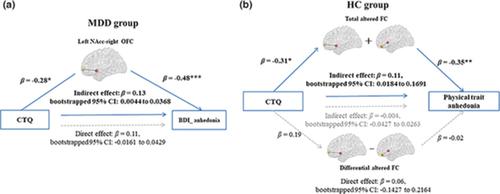当前位置:
X-MOL 学术
›
Hum. Brain Mapp.
›
论文详情
Our official English website, www.x-mol.net, welcomes your
feedback! (Note: you will need to create a separate account there.)
Childhood trauma is associated with elevated anhedonia and altered core reward circuitry in major depression patients and controls
Human Brain Mapping ( IF 3.5 ) Pub Date : 2020-10-08 , DOI: 10.1002/hbm.25222 Jie Fan 1, 2, 3 , Wanting Liu 1 , Jie Xia 1 , Sihui Li 1 , Feng Gao 1 , Jiang Zhu 1 , Yan Han 1 , Huan Zhou 1 , Haiyan Liao 4 , Jinyao Yi 1 , Changlian Tan 4 , Xiongzhao Zhu 1, 2, 3
Human Brain Mapping ( IF 3.5 ) Pub Date : 2020-10-08 , DOI: 10.1002/hbm.25222 Jie Fan 1, 2, 3 , Wanting Liu 1 , Jie Xia 1 , Sihui Li 1 , Feng Gao 1 , Jiang Zhu 1 , Yan Han 1 , Huan Zhou 1 , Haiyan Liao 4 , Jinyao Yi 1 , Changlian Tan 4 , Xiongzhao Zhu 1, 2, 3
Affiliation

|
Childhood trauma (CT) is a well‐established risk factor for major depressive disorder (MDD). However, the underlying mechanism linking CT and MDD remains not fully understood. The present study tested the hypothesis that CT have effects on specific types of anhedonia in depression via reward system. To do so, we evaluated different aspects of anhedonia and resting‐state functional connectivity (FC) in reward system among 66 patients with MDD (44 with moderate‐to‐severe and 22 with no or low CT), and 57 healthy controls (HC; 23 with moderate‐to‐severe and 34 with no or low CT). Results showed that MDD patients with moderate‐to‐severe CT suffered more severe state anhedonic depression than patients with no or low level of CT. Individuals with moderate‐to‐severe CT, irrespective of MDD diagnosis, had elevated physical, social and anticipatory but not consummatory trait anhedonia, and demonstrated decreased left nucleus accumbens (NAcc)‐right orbital frontal cortex (OFC) and left ventral caudate‐left OFC connectivity compared to those with no or low exposure. Left NAcc‐right OFC connectivity mediated relationship between CT and state anhedonia in MDD. The total altered ventral striatum (VS)‐OFC connectivity mediated links between CT and physical trait anhedonia in HC. These findings highlight specific types of anhedonia and the core reward system as targets of CT. Blunted hedonic responses via decreased coupling within core reward system may be involved in the mechanism of depression following CT. Implications for clinical interventions are also discussed.
中文翻译:

童年创伤与重度抑郁症患者和对照组的快感缺失升高和核心奖励回路改变有关
童年创伤(CT)是重度抑郁症(MDD)的一个公认的危险因素。然而,连接 CT 和 MDD 的潜在机制仍不完全清楚。本研究检验了 CT 通过奖励系统对抑郁症中特定类型的快感缺失产生影响的假设。为此,我们评估了 66 名 MDD 患者(44 名中度至重度,22 名无或低 CT)和 57 名健康对照者(HC ; 23 例为中度至重度,34 例为无或低 CT)。结果显示,具有中重度CT的MDD患者比没有或低水平CT的患者患有更严重的状态快感缺失抑郁。患有中度至重度 CT 的个体,无论 MDD 诊断如何,其身体、社交和预期性快感缺失均升高,但并非完成性特征,并表现出左伏隔核 (NAcc)-右眶额皮质 (OFC) 和左腹尾状核-左的减少OFC 连接与没有或低暴露的连接相比。 MDD 中左 NAcc-右 OFC 连接介导 CT 和状态快感缺乏之间的关系。腹侧纹状体 (VS)-OFC 连接的总改变介导了 HC 中 CT 和身体特征快感缺失之间的联系。这些发现强调了特定类型的快感缺失和核心奖励系统作为 CT 的目标。核心奖励系统内耦合减少导致的享乐反应迟钝可能与 CT 后抑郁的机制有关。还讨论了对临床干预的影响。
更新日期:2020-10-08
中文翻译:

童年创伤与重度抑郁症患者和对照组的快感缺失升高和核心奖励回路改变有关
童年创伤(CT)是重度抑郁症(MDD)的一个公认的危险因素。然而,连接 CT 和 MDD 的潜在机制仍不完全清楚。本研究检验了 CT 通过奖励系统对抑郁症中特定类型的快感缺失产生影响的假设。为此,我们评估了 66 名 MDD 患者(44 名中度至重度,22 名无或低 CT)和 57 名健康对照者(HC ; 23 例为中度至重度,34 例为无或低 CT)。结果显示,具有中重度CT的MDD患者比没有或低水平CT的患者患有更严重的状态快感缺失抑郁。患有中度至重度 CT 的个体,无论 MDD 诊断如何,其身体、社交和预期性快感缺失均升高,但并非完成性特征,并表现出左伏隔核 (NAcc)-右眶额皮质 (OFC) 和左腹尾状核-左的减少OFC 连接与没有或低暴露的连接相比。 MDD 中左 NAcc-右 OFC 连接介导 CT 和状态快感缺乏之间的关系。腹侧纹状体 (VS)-OFC 连接的总改变介导了 HC 中 CT 和身体特征快感缺失之间的联系。这些发现强调了特定类型的快感缺失和核心奖励系统作为 CT 的目标。核心奖励系统内耦合减少导致的享乐反应迟钝可能与 CT 后抑郁的机制有关。还讨论了对临床干预的影响。











































 京公网安备 11010802027423号
京公网安备 11010802027423号